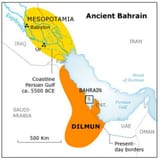Search Results
7/3/2025, 8:09:49 AM
>>509374856
>This theory was accepted by the 19th-century German classicist Arnold Heeren who said "In the Greek geographers, for instance, we read of two islands, named Tyrus or Tylos, and Aradus, which boasted that they were the mother country of the Phoenicians, and exhibited relics of Phoenician temples." The people of Tyre in particular have long maintained Persian Gulf origins, and the similarity in the words "Tylos" and "Tyre" has been commented upon
>The name Tylos is thought to be a Hellenisation of the Semitic Tilmun (from Dilmun). The term Tylos was commonly used for the islands until Ptolemy's Geographia when the inhabitants are referred to as Thilouanoi. Some place names in Bahrain go back to the Tylos era; for instance the name of Arad, a residential suburb of Muharraq, is believed to originate from "Arados", the ancient Greek name for Muharraq
>Dilmun, or Telmun, (Sumerian: , later 𒉌𒌇(𒆠), NI.TUKki = dilmunki; Arabic: دلمون) was an ancient East Semitic–speaking civilization in Eastern Arabia mentioned from the 3rd millennium BC onwards, covering the transition from Prehistoric Arabia into the historic period. Based on contextual evidence, it was located in the Persian Gulf, on a trade route between Mesopotamia and the Indus Valley civilisation, close to the sea and to artesian springs. Dilmun encompassed Bahrain, Kuwait, and eastern Saudi Arabia
>The great commercial and trading connections between Mesopotamia and Dilmun were strong and profound to the point where Dilmun was a central figure to the Sumerian creation myth. Dilmun was described in the saga of Enki and Ninhursag as pre-existing in paradisiacal state, where predators do not kill, pain and diseases are absent, and people do not get old
>This theory was accepted by the 19th-century German classicist Arnold Heeren who said "In the Greek geographers, for instance, we read of two islands, named Tyrus or Tylos, and Aradus, which boasted that they were the mother country of the Phoenicians, and exhibited relics of Phoenician temples." The people of Tyre in particular have long maintained Persian Gulf origins, and the similarity in the words "Tylos" and "Tyre" has been commented upon
>The name Tylos is thought to be a Hellenisation of the Semitic Tilmun (from Dilmun). The term Tylos was commonly used for the islands until Ptolemy's Geographia when the inhabitants are referred to as Thilouanoi. Some place names in Bahrain go back to the Tylos era; for instance the name of Arad, a residential suburb of Muharraq, is believed to originate from "Arados", the ancient Greek name for Muharraq
>Dilmun, or Telmun, (Sumerian: , later 𒉌𒌇(𒆠), NI.TUKki = dilmunki; Arabic: دلمون) was an ancient East Semitic–speaking civilization in Eastern Arabia mentioned from the 3rd millennium BC onwards, covering the transition from Prehistoric Arabia into the historic period. Based on contextual evidence, it was located in the Persian Gulf, on a trade route between Mesopotamia and the Indus Valley civilisation, close to the sea and to artesian springs. Dilmun encompassed Bahrain, Kuwait, and eastern Saudi Arabia
>The great commercial and trading connections between Mesopotamia and Dilmun were strong and profound to the point where Dilmun was a central figure to the Sumerian creation myth. Dilmun was described in the saga of Enki and Ninhursag as pre-existing in paradisiacal state, where predators do not kill, pain and diseases are absent, and people do not get old
Page 1
